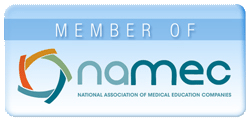Detect and Defeat: Improving Awareness of the Differences in Narcolepsy and Novel Strategies for Treatment
Premiere Date: Wednesday, April 6, 2022This activity offers CE credit for:
- ABIM (MOC)
- Medicine (accme)
- Nursing (ANCC)
- Pharmacy (acpe)
- PA (aapa)
- Other
All other clinicians will receive a Certificate of Attendance stating this activity was certified for AMA PRA Category 1 Credit™
Credit Expiration Date:
Wednesday, May 31, 2023
Note: Credit Is No Longer Available
 | Richard K. Bogan, MD, FCCP, FAASM (Moderator) Associate Clinical Professor University of South Carolina Medical School, Columbia, SC Medical University of South Carolina, Charleston, SC Principal, Bogan Sleep Consultants, LLC Charleston, SC |
 | Clete A. Kushida, MD, Ph.D Neurologist, Division Chief, and Medical Director Stanford Sleep Medicine Professor and Associate Chair, Department of Psychiatry and Behavioral Sciences Stanford University Redwood City, CA |
 | Anne Marie Morse, DO, FAASM Director, Child Neurology Director, Pediatric Sleep Medicine Clinical Associate Professor Geisinger Commonwealth School of Medicine Geisinger Medical Center Janet Weis Children's Hospital Danville, PA |
Narcolepsy is a disabling neurodegenerative condition characterized by excessive daytime sleepiness (EDS), cataplexy, as well as other symptoms impacting quality of life (QoL) and daily functioning. Despite the wide-ranging disability narcolepsy confers, it is often under-recognized and misdiagnosed, with failure to distinguish narcolepsy subtypes (NT1 and NT2) resulting in persistent burden. Stimulants are typically utilized as first-line therapies, though they often offer limited effectiveness and/or safety concerns. Data is rapidly emerging in support of the use of non-stimulant therapies to improve patient outcomes as well as adherence.
Join expert faculty in this live and OnDemand initiative as they discuss effective tools and strategies to improve the accurate and early detection of narcolepsy, as well as the latest evidence on optimal treatment strategies to achieve sustained benefits by improving clinical outcomes and facilitating adherence.
At the end of this CE activity, participants should be able to:
- Recognize the varied presentation of narcolepsy diagnosis.
- Differentiate the clinical, functional, and psychosocial impact of NT1 versus NT2.
- Evaluate the latest safety and efficacy data on novel and emerging strategies to reduce the burden and impact of EDS and cataplexy in adults with narcolepsy.
Supported by an educational grant from Avadel CNS Pharmaceuticals, LLC.
Physicians, PAs, nurse practitioners, nurses, and pharmacists specializing in sleep, pulmonology, psychiatry, neurology, and/or primary care.
ABIM MOC Credit:
Successful completion of this CME activity, which includes participation in the evaluation component, enables the participant to earn up to 1.5 medical knowledge MOC points in the American Board of Internal Medicine's (ABIM) Maintenance of Certification (MOC) program. Participants will earn MOC points equivalent to the amount of CME credits claimed for the activity. It is the CME activity provider's responsibility to submit participant completion information to ACCME for the purpose of granting ABIM MOC credit.
Learning Format:
Enduring material
Royal College MOC:
Through an agreement between the Accreditation Council for Continuing Medical Education and the Royal College of Physicians and Surgeons of Canada, medical practitioners participating in the Royal College MOC Program may record completion of accredited activities registered under the ACCME's "CME in Support of MOC" program in Section 3 of the Royal College's MOC Program.
MIPS Improvement Activity:
This activity counts towards MIPS Improvement Activity requirements under the Medicare Access and CHIP Reauthorization Act of 2015 (MACRA). Clinicians should submit their improvement activities by attestation via the CMS Quality Payment Program website.
Dr. Bogan reports the following financial relationships:
Consultant: Harmony Biosciences, LLC; Jazz Pharmaceuticals, Inc.; and Takeda Pharmaceuticals U.S.A., Inc.
Grants: Axsome Therapeutics, Inc.; Eisai Inc.; Flamel Technologies; Fresca Medical, Inc.; Harmony Biosciences, LLC; Idorsia Pharmaceuticals; Jazz Pharmaceuticals, Inc.; Merck & Co., Inc.; Philips; Suven Life Sciences; and Takeda Pharmaceuticals U.S.A., Inc.
Speakers Bureau: Eisai Inc.; Harmony Biosciences, LLC; and Jazz Pharmaceuticals, Inc.
Dr. Kushida reports the following financial relationships:
Advisory Board: Avadel Pharmaceuticals
Consultant: Cerebra; Eisai; Idorsia; Jazz Pharmaceuticals, Inc.; Koko; Merck Sharp & Dohme; and XW Pharma
Research Support: Avadel Pharmaceuticals; Eisai; Jazz Pharmaceuticals, Inc.; and N:S Pharmaceuticals
Speakers Bureau: Avadel Pharmaceuticals and Jazz Pharmaceuticals, Inc.
Stock Shareholder (Directly Purchased): Koko; M3 Public Benefit Corporation; Restful Robotics; and Vivos
Dr. Morse reports the following financial relationships:
Advisory Board: Avadel Pharmaceuticals and Jazz Pharmaceuticals, Inc.
Consultant: Avadel Pharmaceuticals; Harmony Biosciences; and Jazz Pharmaceuticals, Inc.
Grants: National Institute of Health (NIH)
Research Support: National Institute of Health (NIH)
Speakers Bureau: Jazz Pharmaceuticals, Inc.
The following peer reviewer and CME Outfitters staff report no financial relationships:
Faculty of this CE activity may include discussions of products or devices that are not currently labeled for use by the FDA. The faculty have been informed of their responsibility to disclose to the audience if they will be discussing off-label or investigational uses (any uses not approved by the FDA) of products or devices.
Questions about this activity? Call us at 877.CME.PROS (877.263.7767).
TV-152-040622-76



